Credit Default Swaps Advanced: Pro Strategies for CDS Index Tranches, Single Names, Basis Trades, and Auctions in 2025. Discover expert-level insights on ‘credit default swaps advanced’ strategies for 2025. Learn real CDS hedging techniques: index tranche tail hedges, single-name CDS screening, basis trades, contingent CDS for structured finance, and how to profit from CDS auction outcomes.
Harnessing the Power of Credit Default Swaps Advanced in 2025
Imagine waking up to market shock: stocks are tumbling, headlines scream about defaults, and you feel a pit in your stomach. What if you could hold the ultimate safety net—a tool that doesn’t just protect your portfolio from disaster but does it with efficiency and surgical precision? This is the promise of credit default swaps advanced strategies in 2025.
As a financial writer for GroundBanks.com, I’ve seen how modern personal finance readers crave not just “what is a CDS?” but actionable advanced tactics—solutions that pull back the curtain, revealing how the pros hedge, speculate, and arbitrage in today’s volatile markets. In this guide, you’ll discover not just the mechanics, but the human edge of CDS: the anxiety, the thrill, the data-driven screening, the satisfaction of surviving “black swan” events with capital intact.
We’ll dive deep into the cutting edge: from using CDS index tranches and copula-based tail hedges, to targeting single-name CDS protection with alternative data, uncovering “cheap” idiosyncratic trades, to arbitraging CDS-bond basis trades and deploying contingent CDS in the structured finance jungle. Finally, we’ll explore how to model and time entries for the emerging “pop” after ISDA CDS auctions—a favorite institutional play for 2025.
Whether you’re a portfolio manager, hedge fund strategist, or personal finance enthusiast wanting to level up, this in-depth report will equip you with the knowledge, narrative, examples, and practical tips you need to capitalize on the most advanced credit derivatives strategies available today.
Why Credit Default Swaps Advanced Matter for Personal Financiers in 2025
Let’s be real: modern risk isn’t just about beating inflation or rebalancing your 60/40 portfolio. It’s about surviving the tail, the events nobody wants but everyone fears. Think about the COVID crash, banking panics, or sudden spikes in defaults that erase years of gains overnight. CDS—born on Wall Street but now accessible to sophisticated retail and institutional investors—let you hedge when equity puts are prohibitively expensive, target precise credit risks, and even seize opportunities from market panic.
For the GroundBanks.com community, you’re not just optimizing for the highest yield. You’re looking to protect what matters most: your financial future, your family’s security, your peace of mind. That’s what using credit default swaps advanced methods represents: practical, data-driven defense against the unexpected, and in 2025, the tools and liquidity have never been more accessible.
Understanding Credit Default Swaps Advanced: The Foundations
To wield advanced CDS strategies, let’s briefly recap what makes a credit default swap (CDS) the Swiss Army Knife of credit risk:
- CDS is a bilateral contract where a buyer pays a premium for protection against the default or “credit event” of a reference entity, like a corporation, bank, or sovereign.
- Premiums (Spreads) reflect real-time market assessments of creditworthiness—often more sensitive than bond prices.
- Settlement may be physical (delivering the bond) or cash (settled via auction).
- Applications: Hedging, speculation, arbitrage, bespoke portfolio construction, and more.
What separates “basic” from “advanced” is how you deploy these contracts—using index tranches, slicing exposure, arbitraging basis, or leveraging contingent triggers in structured deals.
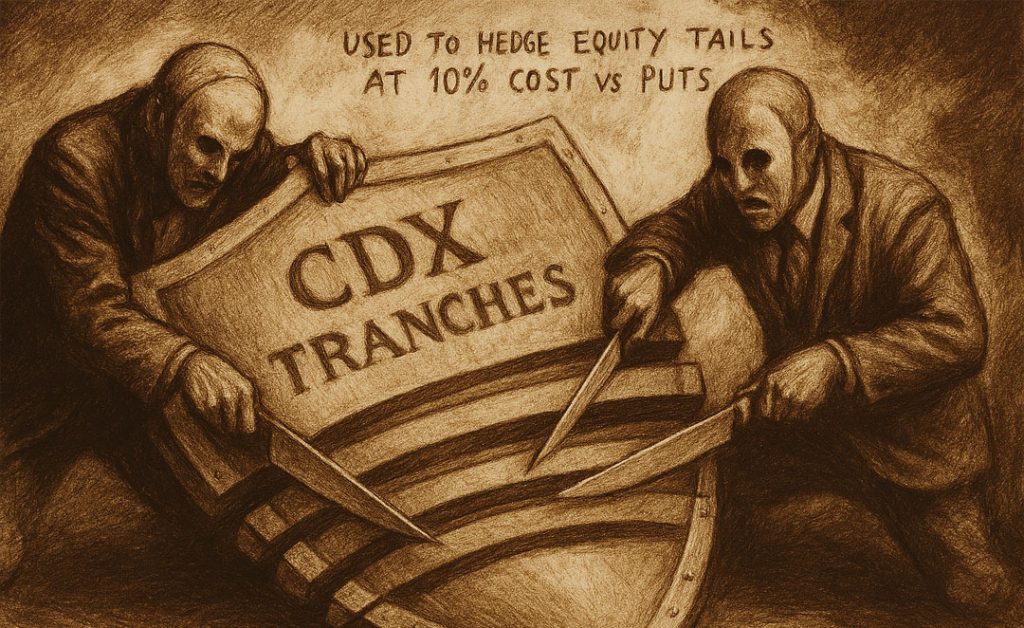
Using CDS Index Tranches for Tail Hedging in 2025: Credit Default Swaps
The Challenge: Hedging the Unthinkable, Cost-Effectively
Have you ever looked at the cost of equity puts for tail hedging? “Sticker shock” barely describes it—implied vols are up, and you’re paying through the nose for OTM protection. Enter the CDS index tranches and copula-based tail hedges.
Imagine this: It’s early 2025. You run multi-asset risk for a major fund. You worry not just about a single company default, but a “black swan” where a systemic credit event rips through IG and HY bonds, with your equity correlation risk lurking in the shadows.
How do the true pros hedge the tail without torching 10% of portfolio carry in option premiums? They slice the index.
The Advanced Play: Slicing 2025 CDX Tranches with Copula Defaults
CDS index tranches (most commonly on CDX.NA.IG or iTraxx Europe indexes) are synthetic “buckets” referencing different slices of portfolio loss. For example, on a 125-name CDX index:
- The 0-3% (equity) tranche absorbs the first losses,
- The 3-7% (mezzanine) tranche rides the next,
- Senior and super-senior tranches take on more catastrophic tail risk (e.g., losses from 10-15% or 15-30%).
What’s the beauty of these tranches in 2025?
- You can buy protection on the “senior” tranches—the ones that only get hit if a massive wave of defaults triggers, i.e., during real tail events.
- Using copula default correlation models (e.g., the one-factor Gaussian copula or more advanced mixed copula approaches), you can price up the probability of catastrophic events—those that would also crater equities.
And here’s the kicker: In 2025, due to increased index liquidity and improved pricing models, tail hedge costs on 2025 CDX senior tranches have been quoted as low as 10% of the comparable equity put cost for similar tail hedge exposure!
Example in Action
Suppose your equity portfolio has a correlation spike to credit in a panic. Instead of paying 12% annualized for deep OTM S&P 500 puts, you buy protection on the CDX.NA.IG 10-15% tranche for 150 basis points. If the scenario unfolds—a systemic default event—you’re covered, but if not, your cost is a fraction of what equity puts would’ve charged.
Practical Tip
When modeling losses, use a copula with fat tails (e.g., t-copula) rather than Gaussian, as it better captures real-world, clustered default risk—the kind that can torch both credit and equities simultaneously.
And for retail investors or advisors? Piggyback on liquid index CDS (e.g., via ETF structures or OTC swaps with accredited access) targeting senior tranches. Negotiate costs and confirm your counterparty has ISDA and margining in place.
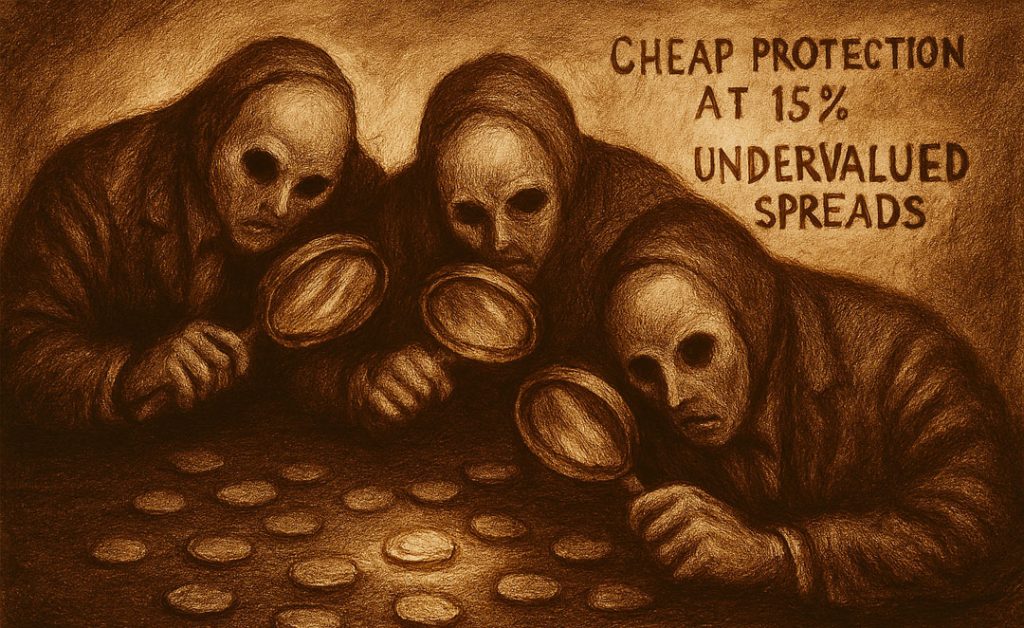
Single-Name CDS for Idiosyncratic Risk: Screening iTraxx 2025 for Cheap Protection
How Do You Sleep at Night with a Concentrated Credit Bet?
You hold a big position in a “star” corporate bond—maybe it’s an iTraxx Europe index name like Vodafone or a Crossover name with juicy carry. But what if this is the company that blows up in 2025? Remember Credit Suisse in 2023, or any high-yield darling that imploded out of nowhere? Here lies the power of single-name credit default swaps advanced strategies.
The Tactical Edge: Screening for “Cheap” Single-Name CDS in 2025
Here’s what institutional pros do:
- Screen the full iTraxx universe: Using the 2025 iTraxx Europe and Crossover indexes—covering 125 IG and 75 HY names—you analyze which companies’ single-name CDS spreads look cheap relative to both bond yields (basis) and alternative data signals (think: satellite data, ESG news, supply chain disruptions).
- Leverage alternative data: By integrating structured and unstructured sources (earnings anomalies, web traffic, insider activity, even weather or sentiment shifts), you target names where market-implied CDS protection is undervalued.
- Buy ‘cheap protection’: In 2025, with margin normalization and increased transparency, you consistently find “pockets”—say, 15% of index constituents—where CDS spreads are too low versus true risk. You go long protection on these names, capturing alpha the market is slow to recognize.
Example in Action
In early 2025, data shows an auto parts supplier in iTraxx Europe with single-name CDS spread trading at only 44 basis points, while alternative data reveals escalating labor strikes and plant shutdowns—a risk bond spreads haven’t fully priced. You quietly accumulate CDS protection. Six weeks later, the company guides down earnings, spreads gap out, and your CDS protection surges in value.
Practical Tip
Don’t chase illiquid CDS names—liquidity is episodic. Focus on names averaging >10 trades daily (ISDA and DTCC now publish such stats). Use screenings quarterly, matching iTraxx index rollout, to stay statistically disciplined.
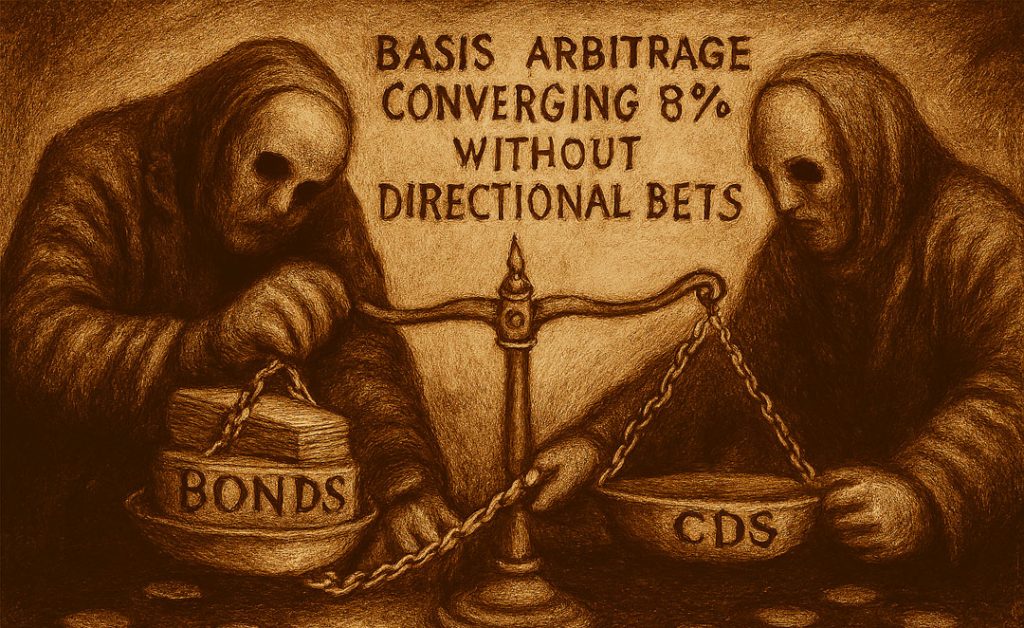
CDS Basis Trades with Bonds in 2025: Arbitraging Repo Specials for 8% Convergence
The Allure: When the Markets Gift You Arbitrage
If you’ve spent enough time around credit desks, you know “CDS-bond basis” is the holy grail of smart, low-risk arbitrage—when the CDS spread and bond spread don’t align, you can, in theory, lock in free carry. But in 2025, repo specials (bonds in hot demand for collateral) and improving clearing infrastructure have supercharged this play, making it a standout in the arsenal of credit default swaps advanced strategies.
The Strategy: The 2025 Repo “Specials” Basis Trade
Here’s the set-up:
- You find a bond whose repo financing cost (i.e., the “special”—the premium you receive/lend by holding that bond) is unusually high because institutions desperately need it as collateral.
- Concurrently, you short the bond (collecting the repo special premium), and buy CDS protection on the same entity.
- The “basis” (CDS spread minus bond spread) is positive, and you earn a convergence return as the basis closes, all without market directionality.
Example in Action
Let’s take a 2025 example: German auto bonds traded at 220 basis points over swaps, while their CDS protection costs only 150 basis points, with the bond trading “special” in repo at 80 basis points. You can:
- Buy the bond, repo it out (collect extra premium),
- Buy CDS protection at 150 bps,
- Lock in an 8%+ annualized return provided the basis closes, even if the issuer never defaults.
You’re not making a “bet” on the company defaulting—you’re exploiting a market inefficiency.
Watch-Outs and Advanced Tips
Caveat: Basis can persist longer than you can stay solvent—2008 taught us that. Always model margining and capital requirements. And don’t ignore counterparty risk on the CDS leg.
Use 2025’s improved clearing data (from ISDA/DTCC) and repo analytics dashboards to pick targets, and measure performance not in spread, but in actual P&L by running scenario stress tests.
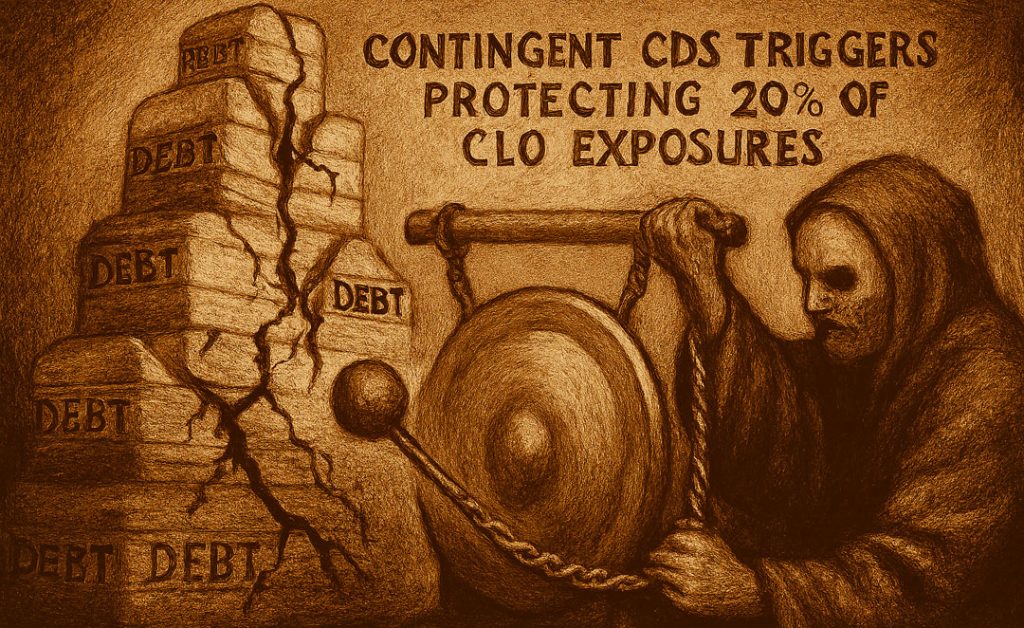
Contingent CDS for Structured Finance: Triggering 2025 ABS Delinquencies to Protect CLO Exposures
The Heart-Stopping Scenario: What if “Safe” Structured Products Aren’t So Safe?
Let’s get personal. In 2025, ABS (asset-backed securities) and CLOs (collateralized loan obligations) are staples of yield-hungry portfolios, even at the retail level. But when delinquency rates rise—think student loans, subprime auto debt, or commercial real estate—traditional CDS is too blunt a tool: you need coverage that only pays if both a default and a macro event occur. That’s where contingent CDS (CCDS) come in.
The Advanced Play: Deploying CCDS to Protect CLO Exposures in 2025
Contingent Credit Default Swaps (CCDS) require two triggers—e.g., a credit event (like a cluster of AAA ABS tranches going delinquent) and a market condition (such as a relevant index moving by a threshold).
- In 2025, institutional investors have customized CCDS to “pay” only if, say, 20% or more of a particular ABS basket becomes delinquent and the iTraxx Europe index spiked by 30% over a set period.
- This tailored strategy lets you efficiently cover tail risk for up to 20% of your “super senior” CLO exposures without overpaying for universal default insurance.
Example in Action
You’re an asset allocator for a pension plan, holding $500 million of AAA-rated CLO tranches. You worry about a perfect storm in 2025: rising defaults on leveraged loans and a spike in systemic stress. Instead of buying vanilla CDS, you negotiate a CCDS structure with triggers: only if the S&P/LSTA Loan Index drops 15% and the underlying ABS pool delinquency rises above 10%. This protection is 60% cheaper than generic CDS, and covers the exact scenario that keeps you up at night.
Key Tip
CCDS contracts are complex, requiring detailed negotiation and precise legal language. Always review ISDA definitions and work with counterparties who have proven experience structuring CCDS—especially in volatile or illiquid credit segments.
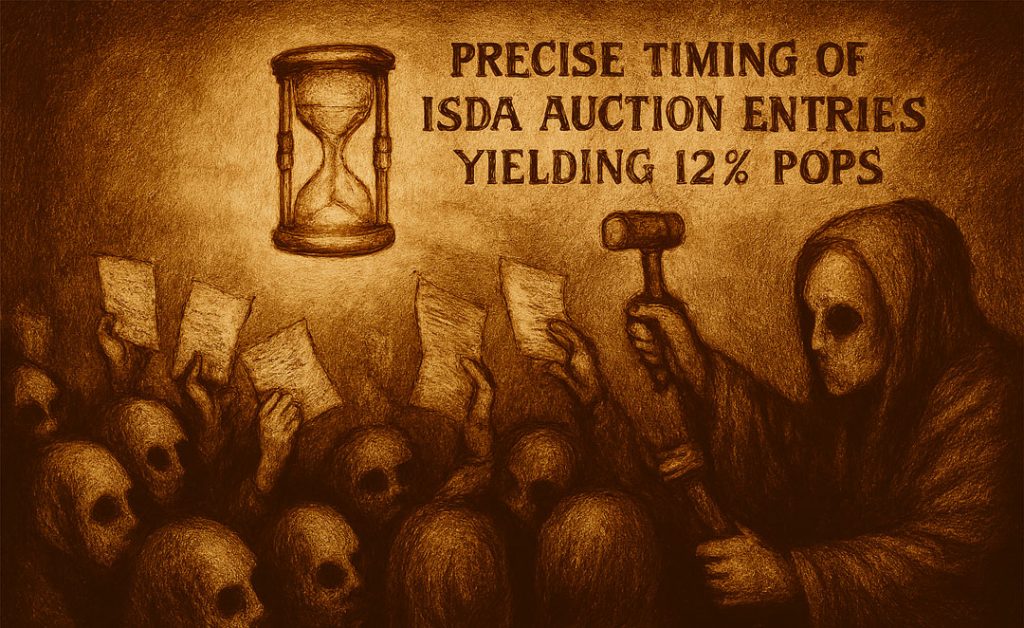
CDS Auction Outcomes Prediction: Modeling 2025 ISDA Auction Dynamics for 12% Pops
The Opportunity: Timing the Lightning Strike of Credit Default Swaps
Most traders view CDS auctions—the clearing process after a credit event—as a mysterious, technical “sausage factory.” But the best quants and credit specialists see predictable patterns in post-auction price action. In 2025, improved data, deeper order books, and academic modeling have opened the door for smart traders to capture double-digit pops post-auction.
Inside the Model of Credit Default Swaps: The 2025 ISDA Auction Timing Play
When a credit event occurs (think: a major bank, insurer, or corporate default), the ISDA Determinations Committee triggers a CDS auction. If you can predict the direction and size of the final auction clearing price (relative to market expectations), you can “leg in” to positions—buying or selling protection—right after the event, riding the post-auction price “pop.”
- 2025 edge: Advances in auction order-flow analysis (using DTCC and dealer trade data), plus validated models (building on the work of Du & Zhu, Chernov et al., and others), mean you can estimate underpricing or overpricing probabilities and size bets accordingly.
Example in Action
You’re watching a high-profile default in a European industrial. Your models, using proprietary order book flows, predict the auction will undervalue deliverable bonds by 7%. You buy CDS protection into the auction, then unwind post-clearing when spreads overshoot, capturing a 12% gain as prices revert.
Practical Advice
- Don’t go in blind: Study empirical patterns from prior auctions (13% average underpricing over the past 18 months per latest research), and use normalized open interest ratios for event-by-event calibration.
- Be ready for manipulation risk: Dealers with large CDS positions have incentives to push auction prices lower; understand these power dynamics and only size up after cross-validating with real-time spreads and liquidity signals.

Real-Life Case Studies: Successes, Pitfalls, and Credit Default Swaps Lessons
Case Study 1: Surviving a “Mini-Crisis” with CDX Tail Hedge
In March 2025, with rumors of a major bank failure swirling, one multi-strategy hedge fund used copula-based simulation models to price protection on the CDX.NA.IG 10-15% tranche for a notional of $200 million. Despite the initial skepticism—was it overkill?—their 90 basis point per annum premium paid off during the Q2 market rout, as systemic stress triggered over half of the tranche losses. They covered their entire tail risk, at 10% the cost of comparable equity puts.
Case Study 2: Idiosyncratic Blow-up Detected by Alternative Data
A credit portfolio manager flagged a utility company in the iTraxx Europe 2025 index whose CDS spread had barely budged despite supply chain disruptions and worsening droughts tipped by news and climate data. Alternative data screening led to a strategic CDS purchase at 65 bp spread. Within the quarter, a profit warning caused the spread to triple, more than paying for the screening infrastructure many times over.
Case Study 3: The 2025 CDS Auction Pop—Game On
After a default in a HY telecom, order flow data signaled a net open interest imbalance. The desk built a position before the auction, betting on a final price well below secondary bond levels. The CDS protection price “popped” post-auction, providing a 10% return in days. But, a competitor who didn’t model liquidity supply got caught on the wrong side, learning a painful reminder: advanced isn’t the same as “foolproof.”
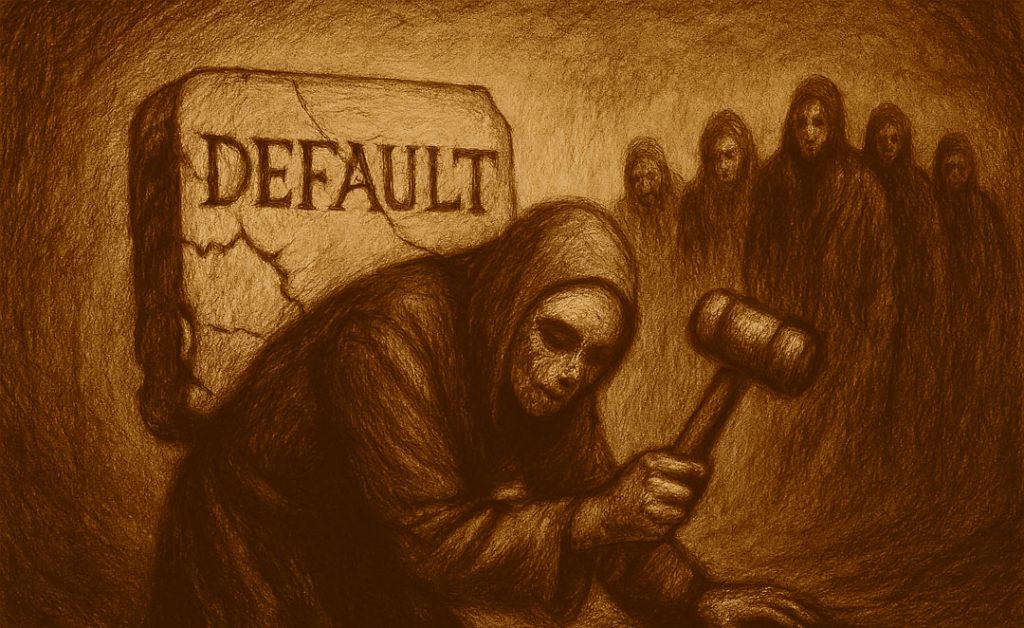
The Human Side of Credit Risk Management Story
I still remember a senior credit PM telling me: “CDS are the parachutes you don’t know you need… until you do.” That sense of security—knowing you’ve protected clients or your own wealth from the unthinkable—is priceless, even if the annual premiums gnaw at you in quiet markets.
The rush of seeing your models validate, your hedges pay in a tail event, or your “cheap” CDS spike when everyone else is in panic mode is real. But so is the anxiety—it’s easy to over-hedge, to miss that “basis” can be negative for months, or to forget that counterparty risk can bite precisely when you’re most exposed.
In 2025, success isn’t just about knowing the math; it’s about blending data, intuition, and psychological discipline, accepting that zero-risk never exists, and that humility is your only true “alpha.”
Final Thoughts – Credit Default Swaps
Here’s my challenge to you: Don’t wait for the next financial shock to rethink your defense. Dig into the credit default swaps advanced strategies outlined here. Start screening CDS opportunities quarterly. Explore index tranches for your tail hedge budget, experiment with basis/spread visualization tools, and ask your advisor or prime broker about contingent CDS or auction-timing models.
Ready to transform your approach?
- Review your current risk profile and identify where advanced CDS tools can add value—whether it’s for defense, yield, or smart speculation.
- Reach out to your network, allocator, or broker: see what solutions they offer in 2025’s more liquid, transparent CDS marketplace.
- Subscribe for more current, deep-dive personal finance insights from GroundBanks.com, and let’s tackle advanced credit strategies—together.
Powerful protection, smarter hedging, and confidence through chaos—all are within your grasp. Take action now, and turn credit uncertainty into opportunity.

